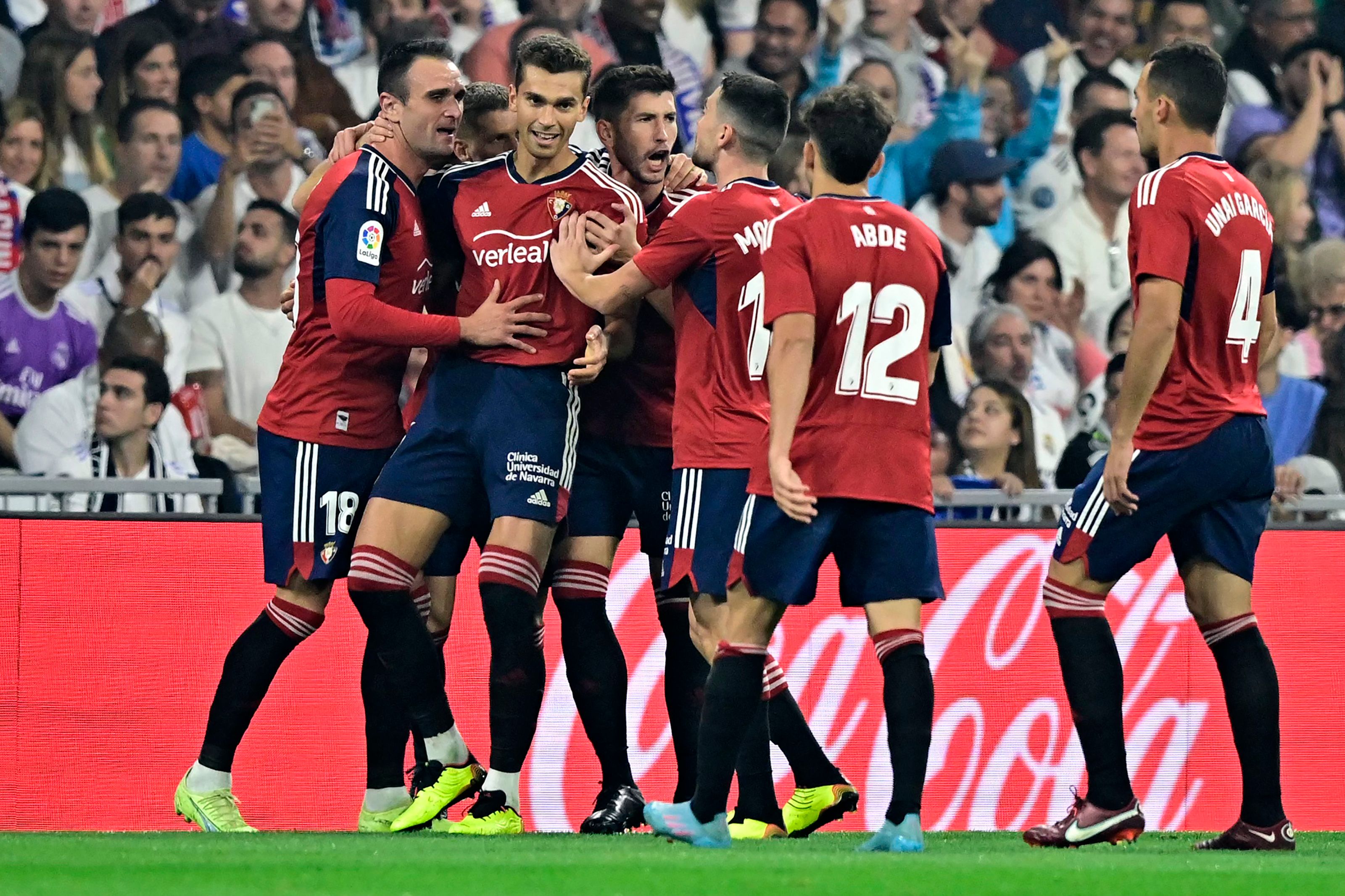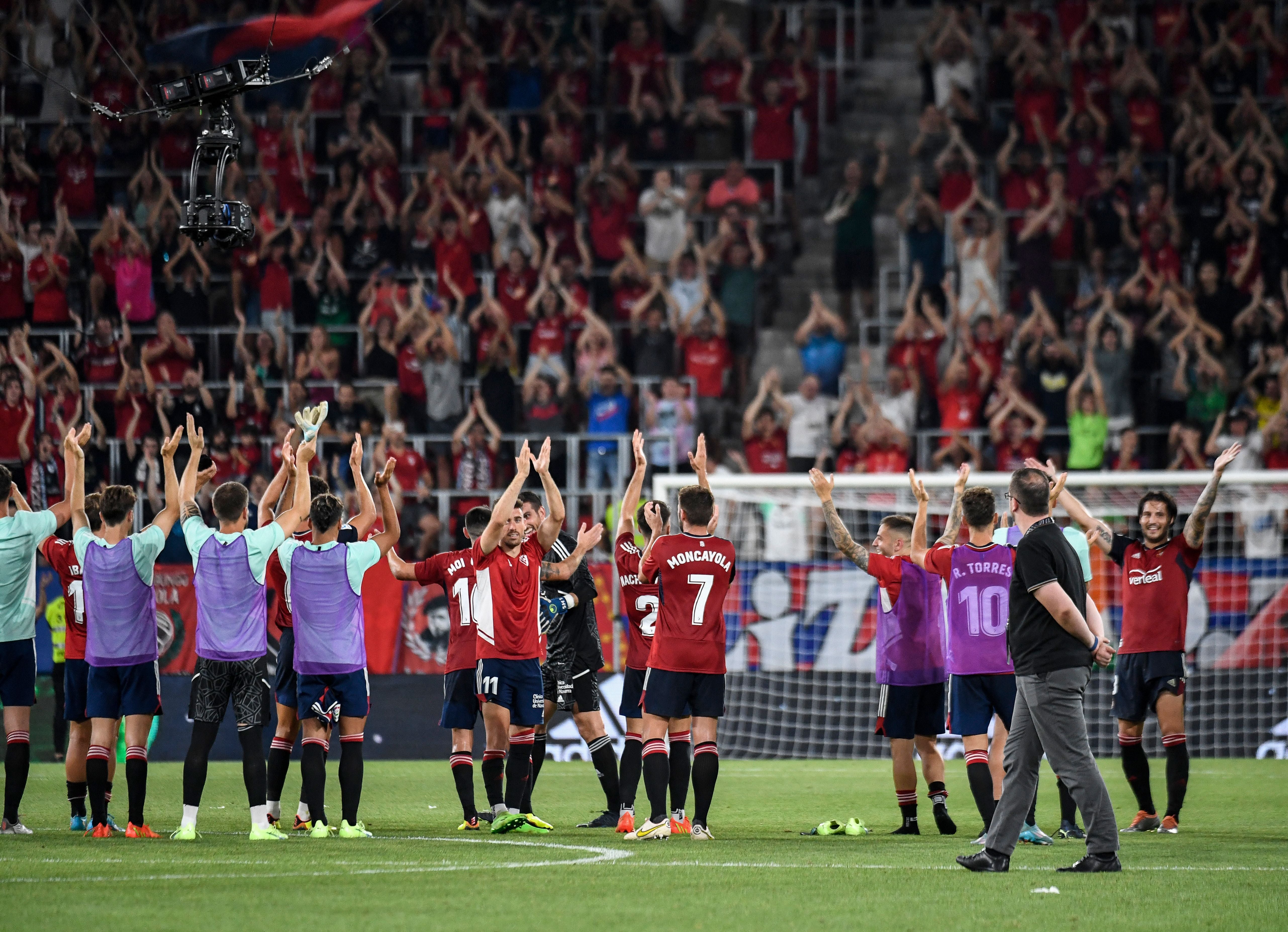
It was when stepping out onto the Santiago Bernabeu pitch, Osasuna’s Jon Moncayola reveals, that he was struck by a sudden realisation.
“We’re playing every weekend with lads we’ve spent many years with in youth teams and, even these days, some of us don’t believe it,” the 24-year-old midfielder explains. “You look at each other and go ‘f**k me, we’re here!’
Despite such sentiments, Moncayola and his pals - for that is pretty much the way to describe them - were more than there to make up the numbers. The numbers in fact look pretty good, amplified as they are by a much more important and distinctive emotion around the club.
Osasuna’s last trip to Real Madrid brought a defiant 1-1 draw, the latest in a series of impressive results that currently has them a point off a European spot in La Liga. That is not despite hailing from a city of just 200,000 people, the famous Pamplona of the San Fermin festival. It is partly because of it. As one of Spain’s four member-owned clubs, Osasuna have made a virtue of such intimacy by basing the entire club on a youth academy that ranks among the best in Europe; of fostering a connection not possible at many grander institutions.
The current squad has nine homegrown players, and they follow a line that includes Champions League and World Cup winners like Cesar Azpilicueta, Javi Martinez and Andoni Goikoetxea. The fans certainly feel that connection, given El Sadar recently produced the highest decibel level in Europe for a football stadium.
“For the number there, they make it sound like somewhere much bigger,” Moncayola enthuses. El Sadar had always been famous as a difficult place to go, where Osasuna claimed some big wins - including Cristiano Ronaldo’s Madrid and Lionel Messi’s Barcelona - but they have started to take such spirit away from home, with more expansive play.
“We were historically a club that was good at home but, away, we’d lose or take what we could get,” club legend and current academy director Patxi Puñal says. “Now we can compete.”
They’re also looking further afield, as Europe is the big ambition for the season. There is a strong argument, however, that Europe should be looking to Pamplona. In a football world of increasing financial stratification, Osasuna are not just a model of how to compete in Spain. They are a model club full-stop.
Fan-owned and now built on youth products, Osasuna’s deep foundation has fostered a sustainable club that has a progressive football ideology and is improving step by step, all while competing with the biggest clubs and still retaining that crucial local connection. It gives them something more. It is what a football club should be.
It should ensure that Osasuna become known for more than historical quirks like the fact they have had more British and Irish players than any other club in Spain. (Sammy Lee, Ashley Grimes, Michael Robinson, Jamie Pollock and Robert Ullathorne, for those wondering).
“If you ask anyone about Navarra,” Moncayola smiles, “they will almost certainly say ‘San Fermin… and Osasuna.”
Like many such stories, such peaks came from a genuine nadir. Few are better placed to appreciate this as Puñal.

He is the local fan who attended games “as a toddler without teeth yet” and went through the ranks to make a record 513 appearances for the club, before eventually moving into his present role as academy director.
Osasuna has been his life, and he’s seen it go through many incarnations. Puñal was in the Savo Milosevic-fired team that finished in the top four in 2005-06 and his final season, in 2013-14, was the club’s penultimate relegation. It could have brought so much worse.
“We’ve lived a bit of everything,” Punal explains. “Difficult moments, very difficult - 2014 was a relegation, 2015 in the second division and only staying up in the last minute. In that moment, a debt appeared of so many millions of euros. Had we gone down to Segunda B, who knows what would have happened the club?“But, from there, I think we’ve marked something.”
It was a classic case of necessity bringing invention, or in this case financial problems bringing so many youth players through.
“Osasuna have always been a club where homegrown players have been important but, in that moment, the club committed to that,” Puñal says. “It initiated a stability from which everything has followed. It started a new process, where the club sorted itself financially and started to expand.”
There has been much more to that expansion, though, than going back to the base and just bringing through players as a matter of course. The academy has instead represented their greatest investment, in terms of intellect as much as finance. The wider province of Navarra has a population of just under 700,000 people and, as Puñal explains, it is one of those places where you will still see kids constantly playing football “on the street”. Osasuna have sought to maximise this, as well as the fact it’s a province where the primary choice are the local club rather than Barcelona or Real Madrid.
“For me, it’s clear the best path to first-team football is Osasuna,” Puñal explains. “It’s true there are times when you can’t compete in certain conditions but we have to fight with our weapons. We have to work a lot. We have to compete in the education we give players. We have to be the best in that, sporting and academic, a structure that gives them everything. This is an advantage of a small community, and it allows us to get to know them well.
“We’re also conscious that not many kids actually make it. But it should be that to go through our academy, our club has not been a waste in their formation, that they’re not just footballers. These are very important things. We’re working to create footballers for our first team, but also people who have more than football.”
In terms of the football itself, Osasuna also have a sophisticated and multi-layered system.
“We have developed it so you can always identify an Osasuna player, an Osasuna team,” Puñal explains. “We have four different models of working we take onto the pitch.
“The formative model is concepts and elements that help our kids to play football anywhere in the world, in Pamplona, Villarreal, Barcelona, if they go to Athletic, wherever. These are the concepts of play, control, passing.
“There’s then model of play, which is the characteristics of Osasuna. To press high, to chase lost balls, attacking from the front, all of that we put into our players.
“Then we have complementary models. So we look for more competitive games for our kids.”

A crucial extra element, that really reflects what the club is about, is that first-team players will train and advise the kids.
“We coach them to correct mistakes, to make them better,” says Moncayola, himself a fan who was brought every weekend from when he was three years old.
“And many more will come because this is something we do well.”
“It is marvellous,” Puñal says. “A coach the kids see every day can say one thing, but when Chimy Avila comes down… oof. That’s not a usual thing, either in Spain or outside. It’s something we do, a connection between the first team and the academy.
“The first team is a reflection of all this.”
Its improvement is also a reflection of how the club has gone step by step, through the divisions, but also in terms of football ideology.
“We were always associated with direct play, long balls, fighting spirit, intensity, never giving in,” Puñal says. “I think Osasuna have completely changed, without losing our idea of play, our philosophy. We compete with teams with possession too.”
The 1-1 draw in the home of the European champions represented so much of this.
“You’ve probably heard a cherished phrase,” Moncayola explains. “It’s Osasuna no se rinde [‘Osasuna never gives in’]. I think that defines that game a bit, playing 20 minutes with 10 men. Last season, too, we got a draw at the Bernabeu.
“There might have been other eras in the club’s history when you went to places like the Bernabeu or Camp Nou and the normal thing is to think ‘how many are we going to lose by today, 4-0, 5-0’ but when you have a plan you believe in, when everyone is convinced, things can happen.”
There is now a quiet optimism something special can happen this season.
“Why can’t we get into Europe, do something really nice,” Moncayola wonders. “It would be a dream… to win a trophy is more difficult but, well, playing in Europe and enjoy those levels would be a dream from when I was small.”
It’s a sentiment that genuinely means more than at most clubs. It is the spirit that propels Osasuna - a small club that may be now Europe’s model club.







